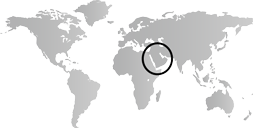By the end of the nineteenth century, the Ottoman empire’s hegemony in western Asia declines, and a new era of European influence and dominance begins. Great Britain consolidates power in the Gulf, controlling the strategic port of Aden in Yemen and the foreign relations of Bahrain, Kuwait, and the future United Arab Emirates. A new educated class emerges, with an enhanced consciousness of their history and a desire to introduce Western science and technology and revive Arab/Islamic culture. Intellectuals begin to call for the reinterpretation of Islam, to reflect what they believe is its inherent consistency with the ideals of modern civilization. Nationalism takes shape in nascent political movements in the region. In the early twentieth century, the beginnings of a modern art movement coincide with a renaissance of Arabic literature. Following the collapse of the Ottoman empire after World War I, Arab aspirations for independence are crushed as Britain and France establish colonial mandates in the Arab provinces. France occupies Syria and Lebanon, while Britain controls Iraq and Palestine and creates Transjordan within the Palestine Mandate. In their mandate, the French increase control by supporting and segregating religious minorities and thus weakening the Arab nationalist movement.
Colonialism, wars, European missionary schools, the cinema, and more recently the mass media all have affected the cultural models and values of the region. In countries such as Syria, their impact is resisted, while in Lebanon the new Western models are completely absorbed. The speed and stages with which modern art is adopted and developed varies from one country to the next; Lebanese and Syrian art movements spring from a long history of commissioning artists for religious frescoes, murals, and icons as early as the sixteenth century, while many Gulf states see no indigenous modern art movements until the 1970s.
Introduction of modern education helps pave the way for advanced training in the arts. Iraqi artists, including women, receive government scholarships to study art in Europe and Cairo. Baghdad’s centrality is secured by its vibrant art discourse; as a result, several art societies are formed such as New Vision, which seeks a unique Iraqi art based on the region’s culture. In the 1930s, women artists in Baghdad and Beirut exhibit in galleries and are offered freedom to participate as equals in growing art movements in a profession deemed unthreatening to patriarchy. Debates over the role of Western forms of expression and Arab authenticity set the background to the anticolonial revolts leading to independence for Syria, Lebanon, Jordan, and Iraq. Arabic poetry takes experimental directions seeking uniquely Arab innovations in form, underpinned by the peak of Arab nationalism in the late 1950s.
After World World II
After the euphoria of national liberation, the new Arab nations struggle with internal and external conflicts that had their seeds in the colonial era. The Palestinian-Israeli conflict results in five wars and, by the end of the century, total occupation of Palestinian territories by Israeli forces; in the process, a million Palestinians are displaced and seek refuge in neighboring Arab countries, where artists find support and contribute to local artistic trends. The Palestinian crisis and Arab-Israeli wars continue to have a profound effect on Arab social and political consciousness, which is reflected in the art of the region. Following the Israeli occupation of the West Bank and Gaza, Palestinian artists establish a movement that, along with film and theater, sustains a national culture of resistance to occupation. By the end of the century, Palestinian artists are in the vanguard of experimental art that gains international recognition.
These events hold very different implications for Jewish art movements. In the early 1900s, Jewish artists arriving from Europe seek to create a unique Jewish form of art fusing modern European Orientalist styles with Middle Eastern cultural influences, depicting biblical themes and Bedouins. In the 1930s, Expressionism becomes popular but is soon overshadowed by events in Europe. In an effort to establish a Jewish historical link to the land, artists seek inspiration in ancient Canaanite mythology and art. By 1948, influential groups like New Horizons turn to abstractionist modes, attempting to forge an Israeli artistic identity recentered around European contemporary art. These trends are challenged by a decade of political and social upheaval following the 1973 Arab-Israeli war. A trend toward individualistic and Conceptual art repoliticizes Israeli art and challenges previous nonpolitical art forms.
From the late 1960s, the regime in Iraq supports the arts by establishing cultural centers in European capitals, organizing regional and international exhibitions, and commissioning public art projects. However, this period of flourishing artistic production is brought to an end with increasing government restrictions on the media and cultural expression. Artists begin to leave Iraq in a wave of migration that lasts into the 1980s, when freedom of movement is restricted. Artists and intellectuals find refuge in the vibrant cultural life of Beirut, but see this space closed off as Lebanon plunges into fifteen years of civil war. With international sanctions imposed on Iraq during the 1990s, the Iraqi art movement is dealt yet another harsh blow as artists are completely isolated from the outside world.
Art patronage interrupted by wars, weak economies, unstable governments, and a limited art market faces many challenges such as insufficient government support, almost nonexistent art professionals and art critics, lack of art journals and functioning national museums, weak art associations, and limited corporate and private support. Throughout the century, individual initiatives sustain the visual arts, nongovernmental art organizations support experimental art and help preserve the visual artistic heritage of the region. But one trend is pervasive from Kuwait to Syria: women artists are at the forefront of the development of these contemporary art centers and movements in the region.


